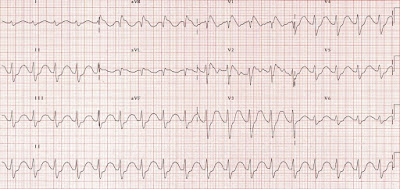Vitals: RR 18/min, HR 110, BP 96/52, SpO2 100 % on 15L NRB. BGL is 102.
Exam: Sternal rub produces eye opening, moaning, and he reaches towards his chest (GCS 9). Pupils are large and reactive, dry oral mucosa, and lungs are clear.
Medical history: Depression and bipolar disorder as per family.
Meds: Zyprexa ™ (olanzapine), Elavil™ (amitriptyline), and Benadryl™ (diphenhydramine).
12-lead EKG: negative for STEMI, shows an incomplete right bundle branch block, QRS duration as interpreted by the monitor is 140ms.
Treatment: saline bolus. Discussion results orders for 2 amps of sodium bicarb. Repeat EKG reveals a narrow QRS and the right bundle branch block has disappeared.
Why do an EKG in overdose?
Numerous prescription medications can produce fatal cardiac arrhythmia with overdose. Logically beta blockers and calcium channel blockers produce bradycardia with varying degrees of AV blocks. Diagnosis and treatment of these medications will be discussed elsewhere. Two much more subtle, but equally deadly cardiac toxicities exist. Widened QRS and prolonged QT. Let’s focus on the widened QRS as its treatment.
- Blockade of sodium channels produces a widened QRS (may be subtle), right axis deviation, and predisposition to ventricular arrhythmias (VT and VF).
- QRS > 100 ms is predictive of seizures (blocks sodium channels in brain)
- QRS > 160 ms is predictive of ventricular arrhythmias (VT/VF)
Sodium channel blockade by medications such as:
Tricyclic antidepressants (Amitriptyline, Desipramine, Imipramine, Nortriptyline)
Antiarrhythmics (Procainamide, Quinidine Encainide, Flecainide)
Local anesthetics (Bupivacaine, Cocaine, Ropivacaine)
Antipsychotics (Thioridazine, and many others)
Antimalarials (Chloroquine, Hydroxychloroquine, Quinine)
Miscellaneous (Amantadine, Diltiazem, Diphenhydramine, Carbamazepine)
- Consider a bicarbonate challenge and repeat EKG in overdose patients with a QRS of greater than 100ms. (These patients deteriorate fast so don’t wait for the arrhythmia or seizure to start treatment.)
- EKG Findings in Sodium Channel Blockade
- Interventricular conduction delay — QRS > 100 ms in lead II
- Right axis deviation of the terminal QRS:
- Terminal R wave > 3 mm in aVR
- R/S ratio > 0.7 in aVR
- Give IV sodium bicarbonate 100 mEq (1-2 mE /kg), (50 mEq in each amp). Repeat every 3 to 5 minutes until QRS narrows. (It’s the sodium part of sodium bicarbonate that “bumps off” the blocker from the sodium channel)Treat hypotension with IV fluid boluses initially.
- Treat ventricular arrhythmias with repeated doses of sodium bicarbonate, early intubation with hyperventilation.
- If bicarb and hyperventilation fail to stop the arrhythmia give lidocaine (1.5mg/kg) IV (competes with the sodium channel blocker for sodium channels)
- Consider giving magnesium sulfate if above treatments are not working.
- AVOID beta-blockers and amiodarone as they may WORSEN both hypotension and cardiac conduction abnormalities.
Pre-treatment EKG
Post-sodium bicarbonate EKG:
References:
Burns, Edward. "Sodium Channel Blocker Toxicity." LIFEINTHEFASTLINE.com. N.p., 16 Mar. 2011. Web. 25 Apr. 2016.
Liebelt, Erica L. "Cyclic Antidepressants." Goldfrank's Toxicologic Emergencies, 10e. Eds. Robert S. Hoffman, et al. New York, NY: McGraw-Hill, 2015. n. pag. AccessEmergency Medicine. Web. 25 Apr. 2016. <http://accessemergencymedicine.mhmedical.com/content.aspx?bookid=1163&Sectionid=65097419>.
LoVecchio, Frank. "Cyclic Antidepressants." Tintinalli’s Emergency Medicine: A Comprehensive Study Guide, 8e. Eds. Judith E. Tintinalli, et al. New York, NY: McGraw-Hill, 2016. n. pag. AccessEmergency Medicine. Web. 25 Apr. 2016. <http://accessemergencymedicine.mhmedical.com/content.aspx?bookid=1658&Sectionid=109413513>.

